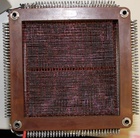Core Memory
Magnetic core memory, or ferrite-core memory, is an early form of random access computer memory. It uses small magnetic ceramic rings, the cores, through which wires are threaded to store information via the polarity of the magnetic field they contain. Such memory is often just called core memory, or, informally, core.
Although computer memory long ago moved to silicon chips, memory is still occasionally called "core". This is most obvious in the naming of the core dump, which refers to the contents of memory recorded at the time of a program error.
The earliest work on core memory was carried out by the Shanghai-born American physicists, An Wang and Way-Dong Woo, who created the pulse transfer controlling device in 1949. The name referred to the way that the magnetic field of the cores could be used to control the switching of current in electro-mechanical systems. Wang and Woo were working at Harvard University's Computation Laboratory at the time, but unlike MIT, Harvard was not interested in promoting inventions created in their labs. Instead Wang was able to patent the system on his own while Woo took ill.
Jay Forrester's group, working on the Whirlwind project at MIT, became aware of this work. This machine required a fast memory system for realtime flight simulator use. At first, Williams tubes (more accurately, Williams-Kilburn tubes) — a storage system based on cathode ray tubes — were used, but these devices were always temperamental and unreliable.
Two key inventions led to the development of magnetic core memory in 1951, which enabled the development of computers as we know them. The first, An Wang's, was the write-after-read cycle, which solved the puzzle of how to use a storage medium in which the act of reading was also an act of erasure. The second, Jay Forrester's, was the coincident-current system, which enabled a small number of wires to control a large number of cores
The above is an extract from Wikipedia - for further details see http://en.wikipedia.org/wiki/Magnetic_core_memory























